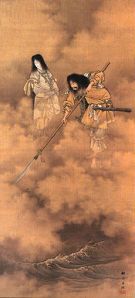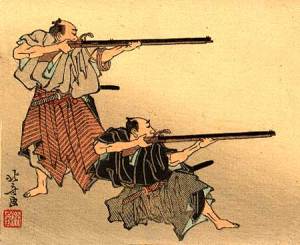From Shiro Kuma's Weblog by kumafr
In this blog I have been speaking a lot about muromachi, azuchi-momoyama, edo, meiji periods. A short listing of the previous periods of Japanese history seem to be a good idea now.
Japanese history is very rich and goes back to the beginning of mankind. As you know, every ryû tries to be linked in time as far as possible in order to give credential to their fighting system. They often try to be originating from the first emperors. Even though one can doubt about the veracity of those facts, it is good to have an overview of Japanese history. As you will see, religions, China, and wars are closely interconnected. Learning the Bujinkan is also trying to understand how this culture is coming from.
Disclaimer: 1) the big periods can be divided into smaller ones named after the emperors, 2) depending on the point of reference there can be discrepancies in the exact duration of any period*. History is not always accurate. But we can see 12 large periods from the beginning to today. I have added links to wikipedia for those interested in having more information on the periods preceding muromachi.
Yayoi period (300 BC – 370 AD): the prehistorical period, tumulus culture. More on Yayoi http://en.wikipedia.org/wiki/Yayoi_period
Yamato period (370 – 538): unification of the country by the Yamato court. ends with the introduction of Buddhism. More on Yamato http://en.wikipedia.org/wiki/Yamato_period
Asuka period (538-710): flourishing of Buddhist art (temple). New organisation of society: Taiki reformation, establishment of Taihô codes. More on Asuka http://en.wikipedia.org/wiki/Asuka_period
Nara Period (710-794): Capital Heijô (Nara prefecture). Shintô based on the Kojiki (712) is the religion of the Kami. The Kojiki depicts the mythology of Japan. More on Nara http://en.wikipedia.org/wiki/Nara_period
Heian period (794-1192): Heian capital (Kyoto). Creation of hiragana. Writing of the Genji Monogatari. Many embassies are sent to China to learn the crafts and Buddhism. Shingon Shu and Tendai Shu are imported to Japan by Kobo Daishi (810) and Dengyo Daishi (805) respectively. This is also at this time that the Gyokko ryû and Kotô ryû are supposedly introduced to Japan from China. During the Genpei war (1182) Minamoto no Yoshinaka captures Kyoto. He is defeated by Minamoto no Yoshitsune. After the defeat, Daisuke Nishina retreats to Togakure mountain (today Togakushi) and changes his name into Daisuke Togakure. He supposedly founded the Togakure ryû. Myôan Eisai comes back from China and establishes the Rinzai sect of Zen Buddhism (Linji in Chinese). More on Heian http://en.wikipedia.org/wiki/Heian_period
Kamakura period (1192-1336): Samurai culture is spreading. The Daibutsu is erected in Kamakura city (Kanagawa prefecture). Minamoto no Yoritomo establishes the Kamakura government (1192). Go Daigo Emperor (1318-1332) saved by Kurando the founder of the Kukishinden ryû. It ends with the overthrowing of the Kamakura government 1333). Foundation of Sôtô Zen by Dôgen coming back from China where he studied Ch’an Buddism. More on Kamakura http://en.wikipedia.org/wiki/Kamakura_period
Muromachi period (1336-1573): Muromachi government in Kyoto established by Ashikaga Takauji. Nô at its peak, Ikebana starts. Ônin wars (1467) opens the sengoku jidai period. Introduction of firearms (1543) by the Portuguese.
Azuchi-momoyama period (1573-1603): Nobunaga overthrows the muromachi government (based in Azuchi castle). Unification of the country finalized by Hideyoshi (momoyama castle). Sen no rikyû perfects sadô (tea ceremony) and becomes the sadô master of Hideyoshi. Many castles are built. Sekigahara wars.
Edo period (1603-1868): Tokugawa Ieyasu creates the Edo government and moves it to Edo (Tokyo). In 1563, Commodore Perry (USA) forces the opening of the country.
Meiji period (1868-1912): Meiji restoration. The samurai lose their power. Japan adopts modern standards. Clans are abolished and swords are banned (1871). The Empire is given a constitution (1889).
Taishô period (1912-1926): The Taishô Emperor is enthroned. Japan gets into WWI in 1914.
Showa period (1926-1989): Enthronement of the Showa emperor Hiro Hito. Japan attacks Pearl harbor (Dec. 1941) and forces the USA to get into WWII. After Japan’s defeat, a democratic constitution is established (1946).
Heisei period (1989- today): Enthronement of Aki Hito. Modern times.
Those 12 periods are the main ones creating the backbone of Japanese culture. It will not change your taijutsu but will help you understanding the “invisible” aspects of our art.
*Alternative list of periods http://www.meijigakuin.ac.jp/~watson/ref/nengo.html
 … Read More
… Read More


 …
… 
 …
… 
 …
… 
 …
…